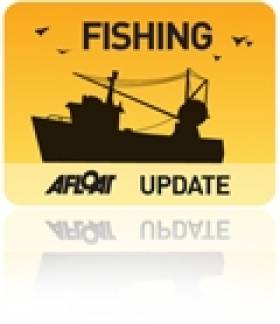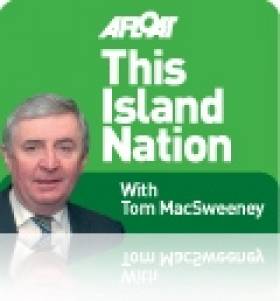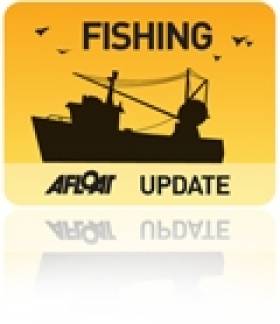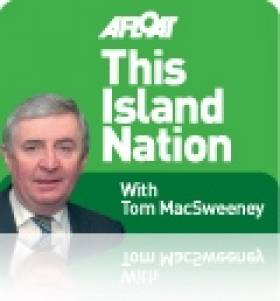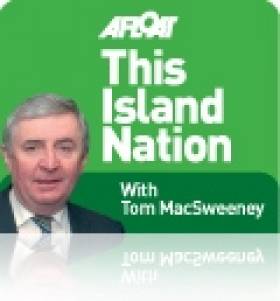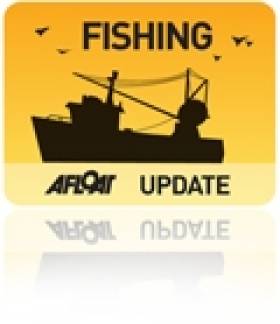Displaying items by tag: Fishing
#FISHING - 'Fish fight' campaigners have cautiously welcomed the EU Council's agreement to end the practice of fish discards, following marathon talks in Brussels.
BBC News reports on what Europe's fisheries ministers are calling a "breakthrough" deal, but one that environmentalists say is too much of a compromise for Europe's oceans.
Provisional dates are already been drawn up to see a ban on discards of mackerel and herring within two years, with a phased ban on discards of cod, haddock, plaice and sole given till 2018 for implementation due to the difficulties in avoiding accidental catch of those species.
Ministers also suggested that different regions of the EU should have more individual control over fisheries policy, and have given themselves till 2020 to end overfishing in European waters.
But Greenpeace and other environmental groups have criticised this timeline, as well as the "vague" wording of proposed limits on fishermen.
"There is a real risk that fish and fishermen are facing another 10 years of overfishing and stock decline, with real consequences for species like cod, hake and tuna," said Greenpeace's Willie Mackenzie.
The compromise deal comes some weeks after Afloat.ie reported plans by an alliance of EU member states to prevent the discards ban.
At present, half of all fish in the North Sea - and up to two-thirds in other areas - are thrown back under the quota system implemented under the EU's common fisheries policy. The practice was recently highlighted by TV chef Hugh Fearnley-Whittingstall's 'Fish Fight' campaign.
The new agreement is still subject to more talks, and must also be passed by the EU Parliament and Commission.
Coveney Attempts to End Fish Discards
#FISH – The Minister for Agriculture, Food and the Marine, Simon Coveney TD, in advance of discussions at the EU Fisheries Council, tabled an approach to end the current practice of discarding of fish at sea. Minister Coveney met fishing industry representatives today and discussed these proposals in advance of the EU Fisheries Council which takes place tomorrow Tuesday 12th June in Luxembourg.
The Fisheries Council will focus on ironing out outstanding political issues in the Common Fisheries Policy (CFP) reform package with the aim of achieving a General Council Approach in advance of future talks with the European Parliament. The Reform of the Common Fisheries Policy is expected to be concluded during the Irish Presidency in the first 6 months of 2013. A key element of the reform is addressing the complex problem of fish discards.
The Minister explained that "while there is general political agreement at the Fisheries Council on the overall objective of gradually eliminating discards, the issue that must be solved is how do we practically achieve a new policy that involves arrangements that are practical from a fisherman's perspective". In order to find solutions, the Minister has tabled a new approach which takes into account the real practical difficulties for fishermen of changing practices, the economic impacts and other constraints which impact fishermen in mixed fisheries. The proposal involves delivering a progressive and phased approach to the obligation to land all catches of quota stocks in a mixed fishery context.
Minister Coveney explained "the approach I favour is focused on incentivising changes in fishing behaviour, reducing catches of juvenile fish and allowing fish stocks to grow over a set period. I believe that this approach stands the best chance of getting buy-in from fishermen and in this way effectively delivering more environmentally friendly fishing practices and sustainable fisheries".
On the overall prospects for tomorrow's meeting the Minister said "I am genuinely hopeful that we can reach a consensus at this Council and send out a strong political signal on the Council's vision for a new CFP in advance of the inter-institutional consultations which will follow over the coming months."
Ireland Needs the Marine Sector
#ISLAND NATION – The Commissioners of Irish Lights, the seafood industry and country's ports and shipping movements all provided indications this week of how important the marine sector is to this nation.
Twenty-one seafood companies are investing €15.5m. and creating 142 jobs at a time when Ireland needs employment. This how the seafood sector is developing. This investment follows investments of €7m. in 2011 and €2.7m. in 2010, all of which indicates a continuing path of development in the fishing industry.
Marine Minister Simon Coveney said the seafood sector is a high growth area of the economy: "The investment involves companies significantly growing their businesses and diversifying, which will lead to increased profitability and increased employment."

Seafood developments
The companies are based in Wexford, Dublin, Cork, Donegal, Galway, Louth and Kerry and their investment is being supported by grants of €3.2 million under the EU co-funded Seafood Processing Business Investment Scheme which is administered by Bord Iascaigh Mhara. BIM is the national fisheries board and its future has been under question in the review of State services. In my view it is time that the future of BIM was clearly and unambiguously stated. It is a necessary part of the fishing industry and must be maintained.
Details of the companies involved in the seafood development are attached at the end of this column.
Light On The Future
I met and interviewed Yvonne Shields several times when she was Director of Strategic Planning and Development at the Marine Institute, responsible for management of the National Marine Research Programme. She is the first lady to become Chief Executive of the Commissioners of Irish Lights. In the current edition of BEAM, the magazine of the Irish Lighthouse Service, she writes that Ireland is on the cusp of great developments in the nation's relationship with its marine resource.
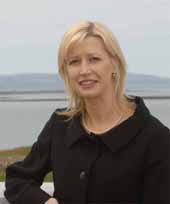
Yvonne Shields CEO of Irish Lights
"These developments will bring great challenges and opportunities," she says, referring to the Government's consultation programme on harnessing Ireland's ocean wealth and securing part of what is a €1.3 trillion global ocean market. "At European level there is a renewed focus on the Atlantic and the need for an integrated strategy for its production and development. Ireland will be central to any Atlantic strategy as, in terms of seabed, we are one of the largest EU States with an area of 900,000kms containing many key resources."
When senior people in the marine sphere put emphasis in public on the importance of our marine resources the maritime sphere is enhanced.
SHIPPING
Bantry Bay Makes The Difference
Glenn Murphy, Director of the Irish Maritime Development Office, has always been clear in his view that the volume of shipping and port traffic indicates the state of the national economy.
"The Irish Ports and Shipping sector is heavily influenced by events globally. As the stability of the European economy remains fragile, uncertainty for Irish consumers and businesses will inevitably persist, which will be clearly reflected in freight volumes passing through Irish ports," he told the European Shortsea Conference in Dublin on Thursday when he said that the volume of shipping and port traffic through Ireland declined in the first quarter of this year.
Lift-on/Lift-off) trades were down 1%; Roll-on/Roll-off by 3%; Break bulk volumes down 4%.Total container traffic declined by one per cent.

An oil tanker transhipment in Bantry Bay
There was growth in oil imports driven by Bantry Bay which recorded a marked increase at its international trans-shipment activity, a crude oil and products facility. Tankers are regular callers to Bantry and can be seen from the shoreside but probably pass unnoticed nationally. Liquid bulk volumes of tanker based petroleum products through Irish ports therefore increased by 30% in the first quarter of the year.
Repelling Pirates
The US-flagged Maersk Texas a container ship thwarted a pirate attack in the Gulf of Oman this week. An onboard security team fired warning shots when pirates in several boats approached the ship north-east of Fujairah. The pirates fired at the ship, but retreated when the security team opened direct fire on them. .
All sailors on board were safe, and the vessel proceeded on its voyage to the US, said Kevin Speers, a Senior Director of Marketing for the Maersk Line. The Iranian Navy issued a statement claiming it had repelled the pirates. Mr Speers said the ship had issued a distress signal and, while the Iranian navy responded, "it was never on scene, our own team dealt with the emergency."
FISHING
Decent Working Conditions
Representatives of the EU's employers and trade unions in the sea fisheries sector have signed an agreement to ensure that fishermen have decent working conditions on board fishing vessels. It lists minimum requirements for conditions of service, accommodation and food, occupational safety and health protection, medical care, and social security.
SAILING
World's Oldest Junk
The world's oldest surviving Chinese junk returned home to Taiwan on Thursday, nearly 60 years after it set sail on a historic voyage to the United States. Called the Free China to mark Taiwan's severance from mainland China arrived in the northern port of Keelung aboard a cargo ship from San Francisco. It will be restored and displayed in a maritime museum in the city, said L.S. Lwo, Head of the Boat Restoration Project. The 100-year-old boat is believed to be the oldest surviving wooden Chinese sailing ship, or junk, in existence and the last of its kind, according to the Chinese Junk Preservation Society which has been trying to save it. The boat and its six crew left Keelung in 1955 to cross the Pacific during a yacht race and arrived in San Francisco after a 112-day voyage. The vessel, which was in need of an overhaul upon arrival, went through several owners and was left in a shipyard while it continued to deteriorate until Taiwan's government stepped in to save it.
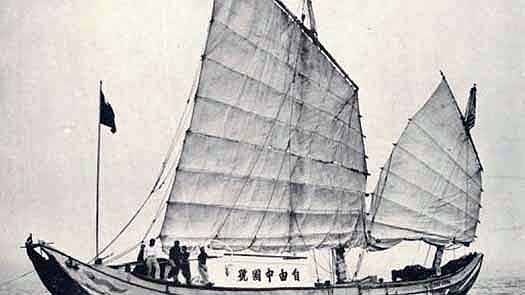
"We are happy that she has arrived safely," said Calvin Mehlert, an original crew member of Free China who has assisted in the junk's return to Taiwan. "We are pleased that Taiwan is going to restore this treasure," he said.
• The photo shows the "Free China" that set sail on a historic voyage from Taiwan to the US nearly 60 years ago.
Remembering Mario
Kinsale held the inaugural Mario Bertelotti Race last Friday night to remember their Club Steward whose kindness and courtesy always impressed when visiting the Kinsale clubhouse. Twenty-eight boats from five classes took part. The trophy was won by Johnny Godkin sailing Godot and presented by Patricia Bertoletti. Second were the MacCarthy Brothers in Mac Magic II. Rob Gill with his A Class came third.
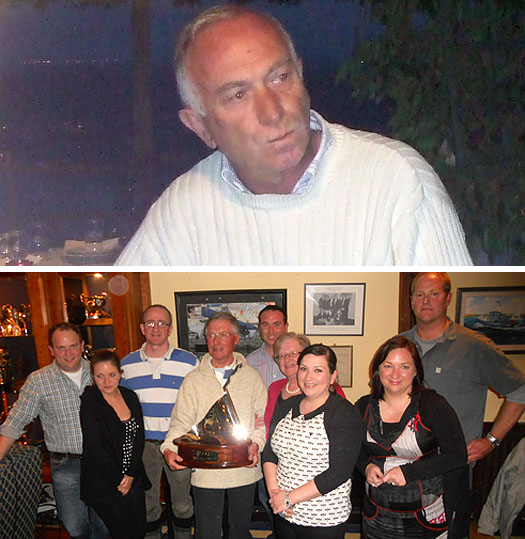
(Above) The Bertoletti family with John Godkin winner of Mario Bertoletti Trophy and Cameron Good, Commodore KYC and (top) the late Mario
At an 'Italian evening' with the Bertoletti family and friends that followed, Commodore Cameron Good spoke about the late Mario and his contribution to Kinsale YC during his time as Club Steward.
WORLD'S GREATEST MARITIME DISASTER
The sinking of the RMS Titanic in 1912, which is being commemorated this centenary year is probably the world's most famous shipwreck, but it was not the biggest.
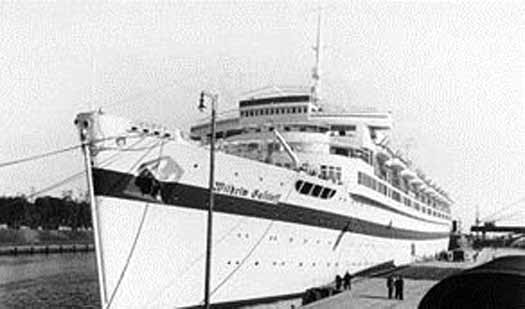
Wilhelm Gustloff sank in wartime
The wartime sinking of the Wilhelm Gustloff during World War II, with the loss of 9,300 people in 1945 remains the greatest maritime disaster ever.
MARINE ENVIRONMENT
Sea level rise near Papua New Guinea in the southwest Pacific is estimated at seven millimetres per year, double the global annual average of 2.8 to3.6 mm.
BEARA'S NEW BOAT
While in Castletownbere on the Beara coastline in the past week I heard about the first vessel of its kind ever to be built in the area. The Orchid was constructed by Beara Iron Works of Eyeries for the Marine Harvest Company. A 15.6 metre work vessel, it will be used to service aquaculture facilities in the South West.
THE SEAFOOD COMPANIES INVESTING €15.5M
|
Beneficiary
|
Project Spend
|
Maximum Grant Approved |
|
Sofrimar Ltd , Kilmore Quay Co. Wexford |
€ 1,430,009 |
€ 357,502.25 |
|
Kilmore Fish Co. Ltd Kilmore Quay Co. Wexford |
€ 273,965 |
€ 63,408.25 |
|
Dunns Seafare Ltd Jamestown Business Pk., Finglas Dublin 11 |
€ 585,000 |
€ 146,250.00 |
|
Atlantis Seafoods Wexford Ltd. Kerlogue Ind. Estate, Rosslare Rd. Wexford |
€ 49,400 |
€ 12,350.00 |
|
Shellfish De La Mer, Dinish Island, Castletownbere, Co. Cork |
€ 488,980 |
€ 122,245.00 |
|
Rockabill Shellfish Ltd, Stephenstown Ind. Estate, Balbriggan, Co. Dublin |
€ 437,239 |
€ 109,309.73 |
|
Sean Ward Fish Exports Ltd. Killybegs Co. Donegal |
€ 755,140 |
€ 188,785.00 |
|
Iasc Mara Teo. ,Rossaveal, Co. Galway |
€ 310,612 |
€ 77,653.00 |
|
Earagail Eisc Teo Meenaneary Carrick Co. Donegal |
€ 895,000 |
€ 223,750.00 |
|
Charlie Vial (Fish Merchant) Ltd, Dunkineely Co. Donegal |
€ 303,256 |
€ 75,814.00 |
|
Premier Fish Ltd. Kinncaslagh Co. Donegal |
€ 6,134,884 |
€ 887,193.90 |
|
Atlanfish Ltd Malin Rd. Donegal |
€ 148,000 |
€ 37,000.00 |
|
Proseail An Clochan Liath Teo. Meenmor Dunglow, Co. Donegal |
€ 591,950 |
€ 147,987.50 |
|
Breizon Ltd, Rossaveal Co. Galway |
€ 12,500 |
€ 3,125.00 |
|
Keohane Seafood Ltd Unit 28, Kinsale Road, Ind. Estate, Kinsale Rd. Co. Cork. |
€ 255,000 |
€ 63,750.00 |
|
Kish Fish Ltd. Malahide Road Industrial Park Coolock, Dublin 17. |
€ 80,625 |
€ 20,156.25 |
|
Seafood Processors Ltd. T/A Morgans Fine Fish, Omeath, Co. Louth |
€ 235,963 |
€ 58,990.75 |
|
Good Fish Processing (Carrigaline) Ltd. Carrigaline Industrial Estate, Crosshaven Rd. Carrigaline Co. Cork |
€ 222,000 |
€ 55,500.00 |
|
Castletown Bere Fishermens Co -op Ltd Castletownbere Co. Cork. |
€ 1,400,000 |
€ 350,000.00 |
|
O Cathain Iasc Teo An Dangain, (Dingle) Co. Kerry |
€ 715,000 |
€ 178,750.00 |
|
Ballycotton Seafoods Garryvoe, Co. Cork. |
€ 219,563 |
€ 54,890.75 |
|
|
|
|
|
TOTAL |
€ 15,544,085 |
€ 3,234,411.38 |
|
|
|
|
Email your comments to: [email protected]
#ISLANDNATION – The sinking of the Titanic in 1912, remembered so much this year in the centenary of the disaster, is probably the most well-known shipwreck, but it is not the greatest maritime disaster ever. If you want to know what that was, go to the full edition of THIS ISLAND NATION, where this week there is more about shipping, the marine environment, fishing and many other aspects of the maritime world. The great variety of the marine sector is what makes it so interesting to write about and report.
The announcement today that, with jobs needed, 21 seafood companies are to provide 142 in Wexford, Dublin, Cork, Donegal, Galway, Louth and Kerry, underlines the importance of the fishing industry which should indicate its economic benefits. It is good to see the industry advancing.
The Irish Ports and Shipping sector is heavily influenced by events globally and, as Glenn Murphy, Director of the Irish Maritime Development Office has pointed out, when the volume of shipping and port traffic drops, that indicates the problems in the Irish economy. This is another example of how this nation depends on the sea. The latest figures were released to the European Shortsea Conference in Dublin yesterday.
Atlas of Trawl Surveys Welcomed
Simon Coveney, TD Minister for Agriculture, Food and the Marine today welcomed the publication of the 'Atlas of Irish Groundfish Trawl Surveys' which was presented to him by Dr Peter Heffernan, Chief Executive of the Marine Institute today (Thursday 24th May).
The Atlas shows the key results from the Irish scientific surveys of the whitefish and deepwater fish stocks in Ireland's 200 mile Exclusive Fisheries Zone. The Atlas provides an overview of the distribution and abundance of adult and juvenile fish species in the waters around Ireland. Thirty two species are described including the main whitefish, midwater fish (herring, mackerel) and shark species caught on the Marine Institute's Groundfish Survey programme. Each species is summarised in terms of its distribution, biological characteristics and temporal changes in abundance.
"Irish Scientists have presented trawl survey data in a visual and non technical format that enables a wider audience to see the biodiversity of fish in Irish waters. This publication has made great strides in illustrating how scientific data can be used to examine the health of our marine ecosystem. Mapping our fish community enables us to have a better understanding of their role in the marine ecosystem. I would like to express my appreciation of the work on the ground in terms of surveys together with the compilation of this user friendly guide by Dr Heffernan and his team in the Marine Institute" explained Minister Coveney.
The Atlas is aimed at those involved in fisheries, environmental policy and management, the fishing industry, environmental Non Government Organisations (NGO's), scientists and the general public. Minister Coveney congratulated the Marine Institute on the Survey Atlas, which is the fourth in the series. Two case studies in the publication illustrate the application of survey data to traditional fisheries advice and to the new form of ecosystem advice that is required by numerous international agreements and under new EU legislation such as the Marine Strategy Framework Directive. "The Common Fisheries Policy reform agenda is currently under discussion by the EU Fisheries Council and the EU Parliament and will continue into the Irish Presidency during the first six months of 2013. The Atlas series provides scientific information that we can all understand and will help inform the CFP debate as we strive to ensure stocks are fished in a sustainable manner." said Minister Simon Coveney.
Previously published atlases include: Commercial Fisheries around Ireland (2009); Atlas of demersal Discarding (2011); and the North Western Waters Atlas (2011).
#ISLANDNATION – What the first woman Chief Executive of Irish Lights thinks about the Irish marine sphere; the first vessel of its kind built in Castletownbere; remembering Kinsale's Mario; China's oldest vessel; an 18th century Russian sailing ship takes to the seas again; decent onboard conditions for fishermen and the greatest maritime disaster ever. All these and more on tomorrow morning's edition of THIS ISLAND NATION on afloat.ie
#THIS ISLAND NATION – The best news for maritime Ireland this week, in my view, was the abandoning of a proposal which could have wiped out the Irish family tradition in fishing.
European bureaucrats have made a shambles of the fishing industry with convoluted regulations and proposals. Fishermen were not properly consulted and the result has been the present mess of the Common Fisheries Policy. There are reasons to believe that EU fisheries officials would prefer a single, centrally-registered and controlled European fishing industry. Introducing ITQs - tradeable fishing quotas - would have facilitated this, allowing big fishing companies to buy up quotas and force smaller, family operators out of business.
Denmark has first-hand experience of this happening. It introduced the system in 2003 and today, according to figures from the Institute of Food and Resource Economics at the University of Copenhagen, 106 fishing vessels catch 90 per cent of all Danish fish. It was the Danish Presidency which went against the Fisheries Commissioner, Maria Damanaki and her officials this week, recommending that each Member State should implement its own management structure for quotas and ITQs should be abandoned.
Marine Minister Simon Coveney saw the dangers which ITQs would have caused to Ireland and fought against their introduction from the outset, having been briefed by the fishing industry. "Privatising fish quotas would have been a serious threat to the economic survival of our coastal communities," he said. "If quotas were traded on the open market they could be bought by international corporations and would no longer be landed into Ireland. This would directly threaten economic activity in our main fishing ports with loss of jobs not only in the fleet but also in fish processing."
EU fisheries officials and their desire for conformity contradict another EU commitment - to the preservation of peripheral communities. Coastal, fishing communities are vital to this nation as is the fishing industry.
Denmark has reduced the maximum share a single fisherman may hold to five per cent of the cod quota and 7.5 per cent of plaice to prevent quotas becoming too concentrated in the hands of too few fishermen. This followed advice that the transferable quota system had reduced competition and allowed a handful of companies to wield too much control.
SHIPPING
HARBOUR MASTERS
The International Harbour Masters' Association met in Cork this week, discussing whether ports could be managed without marine experience.
The role of the Harbour Master in port management and development, the legal powers of the office in today's commercial environment, the decline of nautical expertise in shipping and the port industry, competition between ports,
International harmonisation of port rules, regulations and procedures, cost-cutting and its effects on safe operations in the ports, were amongst the topics debated.
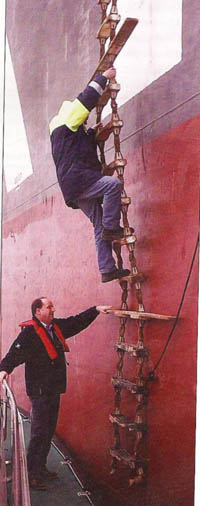
Harbour Masters' work reviewed in Cork
The Nautical Institute, which is celebrating 40 years' in existence, is the international representative body for maritime professionals and has a strong presence in Ireland.
Captain Jim Robinson, retired from the Naval Service here, is the Institute's President.
It operates a distance learning certification scheme for Harbour Masters and has published the third edition of its book, 'The Work of the Harbour Master,' which reflects the diversity of the job.
CRUISE SHIP SAFETY
Writing in the May edition of SEAWAYS, the journal of the Nautical Institute, a former UK Royal Naval Commander calls for an inquiry into passenger safety at sea, following the several incidents this year aboard cruise ships.
"About a year ago I drew attention to the increasing size of cruise ships, leading to passenger numbers that had increased to a level which could not be managed in an emergency," says Cdr.J.A.Holt, MBE., in an interesting letter to the journal reflecting increasing concern about the issue.
"The concept of the ship being its own lifeboat has been utterly discredited. There is no such thing as an unsinkable ship, nor a shipping company who can guarantee immunity from human error or equipment failure. A thorough enquiry into passenger safety at sea is now demanded and perhaps it would be appropriate for The Nautical Institute to lead such an enquiry," he writes.
PANAMA CANAL TOLL INCREASES OPPOSED
The Panama Canal Authority is to hold a public hearing next Wednesday, May 23, about its proposal that is being opposed by shipowners, to increase canal tolls by 15 per cent for large ships and over 60 per cent and up to as much as 100 per cent for smaller vessels. The increases would be from $500 to $800 for smaller ships of less than 15 metres and from $1,500 to $3,200 for the largest, more than 30 metres.
The increases are likely to eventually affect consumer prices for products carried aboard vessels transiting the canal. The increase is due to take effect from July but cannot be imposed until approved by the government of Panama. This is likely to follow the public hearing.
MARINE LEISURE
CRAFTY MEN – AND WOMEN WELCOME !
Knots, ropes and splicing are just some of the craftwork which a sailor needs to know, bearing in mind the advice of Alvin Smith that: "A good knot on a bad rope is no better than a bad knot" and they can be difficult to learn. So at Cronin's Pub in Crosshaven in Cork Harbour 'crafty men' have been gathering tonight to develop these skills.
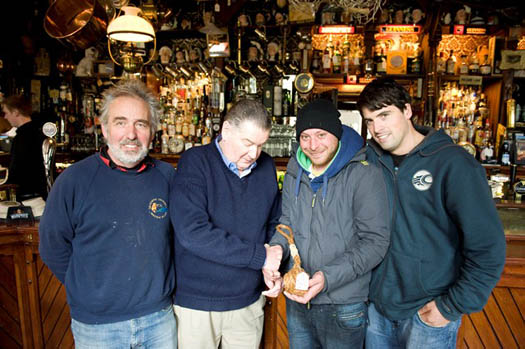
Tom Archer presenting his 'monkey first' to proprietor Sean Cronin in the company of RCYC sailor Nicholas O'Leary on right and Darryl Hughes, owner of the classic boat Maybird on left. Photo: Joleen Cronin
Traditionally scruffy rope ends on deck were the sign of a carelessly run ship, boat or yacht. So being good at rope work indicates a better quality vessel, I am told! In Cronin's the walls are adorned with historical artefacts and pictures of old sailing boats and shipwrecks. It is a maritime location and, like many mariners I occasionally ramble into the premises, whose history dates back to 1892. 'Crafty Mensday,' actually a maritime evening was started there by the 'guys of Crosshaven' as an alternative to ladies' Knit and Natter' sessions.
"The guys were getting a bit jealous of the ladies up-skilling themselves and decided to Knot instead of Knit," proprietor Sean Cronin told me.
Rope splicing, knot-tying and other marine handy work is taught to anyone who turns up on every second Wednesday night and the learning process is succeeding as our photograph shows of Tom Archer presenting his 'monkey first' to proprietor Sean Cronin in the company of RCYC sailor Nicholas O'Leary and Darryl Hughes, owner of the classic boat Maybird. The "crafty men's" get-togethers will continue every second Wednesday night until August. The next dates are May 30; June 13/27; July 11/25 and August 8/22
Sessions are open to all who would like to attend. They operate on a 'skills-exchange' format, with essential knots and other rope skills like splicing being shared around the table. Despite the name, ladies are welcome I am told.
TALL SHIPS AND WASTED MONEY
The British tall ship Pelican went on sale this week for an asking price of stg£2.45 million. She has a steel hull and is 148ft.long overall. The insurance money for ASGARD II would have bought Pelican. Willie O'Dea, Minister responsible for the ship at the time promised to replace ASGARD, but handed the money over to the Department of Finance. The national sail training programme was closed in subsequent cutbacks.

Pelican for sale
Can you ever believe what politicians say?
Once again Ireland will be without a State sail training vessel when the Tall Ships Race comes to Dublin from August 23-26.
Another legacy left behind by Fianna Fail and Willie O'Dea in particular!
MARINE ENVIRONMENT
PROTECTING CORAL
The World Wildlife Fund, WWF and its partners have announced that the first-ever Coral Triangle Day will be held on June 9 at several locations around the Coral Triangle region to highlight the importance of marine conservation and raise awareness on this global centre of marine biodiversity.
The Coral Triangle is a six million square-kilometre ocean expanse that contains the highest number of reef building corals on the planet, spanning across six countries in Asia and the Pacific including Indonesia, Malaysia, Papua New Guinea, the Philippines, Timor and Solomon Islands. Its spectacular coral reefs systems are home to thousands of whales, dolphins, rays, sharks and six of the world's seven species of marine turtles. The Triangle is also a nursery ground for tuna and reef fish species. It sustains the lives of an estimated 120 million people who depend on marine resources for food and income.
Coastal development, overfishing, unsustainable tourism, illegal trade in endangered species and climate change are reported to be taking a heavy toll on this fragile marine ecosystem.
Email me with your comments to: [email protected] or leave your comment below
Follow me on Twitter: @TomMacSweeney and on Facebook
GET THE MONTHLY THIS ISLAND NATION NEWSLETTER: Sign-up at: [email protected] to receive my monthly newsletter summary to your Email on the first Friday of each month. Please put 'newsletter' in the subject line of your email.
Coveney Welcomes Danish Proposal on Fish Stocks
#FISHING – Marine minister, Simon Coveney T.D. at today's EU Fisheries Council welcomed the Danish Presidency proposal which allows each Member State to implement its own management arrangement for fish quotas. Ireland had strongly opposed the EU Commission proposal that would have required all Member States to privatise national fish quotas, and allow them to be traded on the open market.
Minister Coveney said "Since my appointment as Minister, I have made the protection of Ireland's fishing resources and fishing industry my top priority. At every available opportunity, such as last month's Fisheries Council, at bilateral meetings with fellow Ministers, I set down my strong opposition to this proposed privatisation of our national fish quotas. Privatising fish quotas would have been a serious threat to the economic survival of our coastal communities. If fish quotas were traded on the open market they could be bought by international corporations and would no longer be landed into Ireland. This would directly threaten economic activity in our main fishing ports with the loss of jobs not only in the fleet but also in the vital fish processing sector".
Minister Coveney added "I have argued consistently that Member States should be able to determine their own management arrangements for their own particular circumstances. In Ireland, fish quotas are a State-owned national asset and can be used to the benefit of our coastal communities and family owned fishing fleet. This win helps us to ensure that the public resource model for our fisheries is not threatened and the family ownership of our fishing fleet is protected". The Common Fisheries Policy reform agenda is under discussion by the EU Fisheries Council and the EU Parliament. This will continue into the Irish Presidency during the first 6 months of 2013. Discussions today focussed on EU funding arrangements under the new Common Fishing Policy, covering the funding for development support, innovation in the seafood sector, scientific advice and control. There were also discussions on providing scientific advice for fish stocks so that in future years there will be greater assurance that stocks are fished in a sustainable manner.
#ISLAND NATION – The historic Asgard I, the original Erskine Childer's yacht which has been under extensive renovation at the National Museum in Dublin is to go on public display this summer. Public involvement is being sought to provide part of the planned exhibition.
Tom MacSweeney has more details in his 'This Island Nation column' below which this week also has reports from Achill, Galway Bay, the fishing and shipping industries and the marine environment. They include the first Chinese offshore exploration and a major international appointment for a Cork seafarer.
THIS ISLAND NATION
I had my first sail of the season on Saturday, not my normal 'opener' of the year in Cork Harbour, but on the waters of Galway Bay. Preparations for the Volvo Race arrival and overall conclusion there in early July are well underway in the midst of the start of the racing season at Galway Bay Sailing Club at Rinville near Oranmore.
It was from the club there that I sailed aboard my son Pat's Contessa 32, Roamer, on what started off as a day of light winds with sunny conditions. Then the skies darkened, it got cold and the wind strengthened so that soon we were beating as the boat shoved waves aside making its course on a voyage of just over two hours to Parkmore near the hallowed, traditional base of the Galway Hookers at Kinvara harbour.
The Contessa range was designed by the legendary David Sadler and is one of the best-known yachts, with a great reputation for seaworthiness. It was good to hold the helm of a yacht again and hear that pleasant rush of water past the hull. There are several classes of boats sailing out of GBSC, with the younger members particularly favouring the Dart 18 catamaran as I saw last Saturday.
ASGARD 1 TO BE OPEN TO PUBLIC FROM JULY – YOU CAN HELP
The restored Asgard 1, the original Erskine Childers yacht which carried out the historic Howth gun-running to the Irish Volunteers in 1914 will go on public display this July, 98 years after the event. The vessel has been restored over several years at the national museum in Collins Barracks Dublin. The present recessionary times restricted funding for the renovation of the building, a former gymnasium where the work was carried out, into a suitable public display area. This has now been resolved and the necessary works are underway. Spars and rigging are the final stages of preparing the yacht itself for display. There has been considerable voluntary effort by a group of boat owners in Howth helping with the renovation of the old mast, booms and standing and running rigging.
Sarah Kingston of the Education Department at the National Museum Decorative Arts & History Section tells me that they are collecting oral histories and memories of people who had some connection to the yacht. "This may be people who served on the Asgard when it was a training vessel, people who were involved in its conservation or people who saw the boat in Kilmainham Jail. We would love people to share their memories, so that these could be incorporated into the exhibition. Their stories would be recorded and quotes of these recordings may be used in the exhibition. It would be great, if you could support our search in any way."
I am delighted to do so. If you can help, if you have memories you can share, contact the museum by Email to: [email protected]
The Asgard exhibition will be a big visitor attraction and show how the marine sphere was vitally involved in Irish history.
ACHILL ISLAND
I was on Achill Island in the past week to launch a book by international artist Alexandra van Tuyll who now lives there. "Sea meets Land" was the appropriate title of the book which is a record of her journey around Ireland in aid of the RNLI. It is composed of her paintings of various locations she chose. There was a big turn-out in Giltie's Pub and Restaurant at Doeega on the westernmost part of the island for the launch. Alexandra was born in the Netherlands and taught art and music before moving to Achill in 2001 to paint full-time. She exhibits solo and in group shows in leading Irish and international galleries and her work is found in both private and public collections.
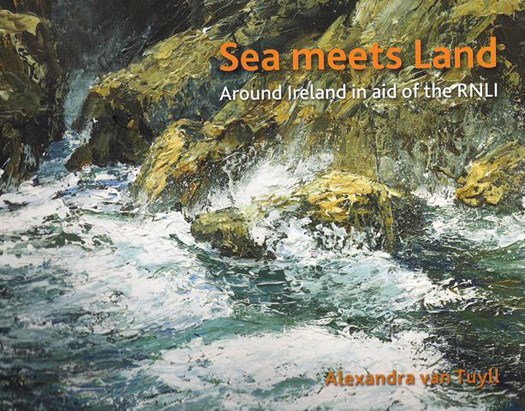
Achill RNLI Book - Sea meets land
Operations Manager at the Achill RNLI Tom Honeyman and the crew and fund-raising supporters invited me to visit the station, a modern building at Cloghmore in the southern part of Achill Sound. The station was established in August 1996 and its all-weather lifeboat is kept on moorings. It is always a pleasure to meet and talk with lifeboat people and this visit underlined the huge community involvement with and pride in the lifeboat.
I wish Alex and the Achill Station every success with the book. It has been published by and is available from Achill Art Press Slievemore Road, Keel, Achill, Co.Mayo or by Emailing: [email protected]
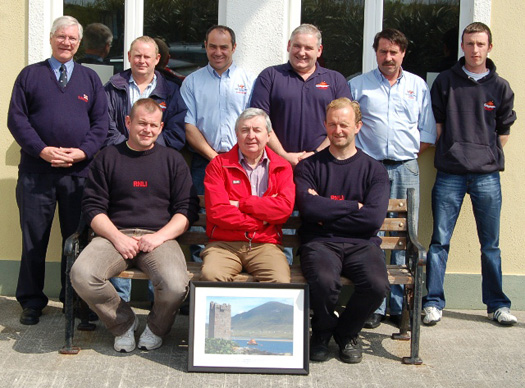
With the Achill Island lifeboat crew
FISHING INDUSTRY NEEDS LOCAL MANAGEMENT
Giving more power to local communities in the fishing industry must be encouraged. There is too much dominance by State and European bureaucracy which has not been helpful. This is underlined in a community-led report published in the biggest whitefish port in the country, Castletownbere in West Cork.
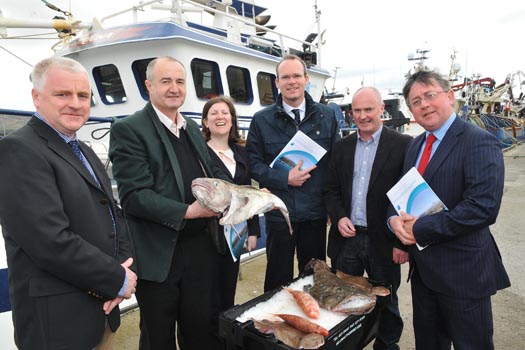
Castletownbere fishing strategy presented to Marine Minister Simon Coveney. L. to R. Liam O'Driscoll, Vice Chairman Irish South and West Fish Producers' Organisation; John Nolan, Castletownbere Fishermen's Co-op; Eibhlin O'Sullivan, CEO, ISWFPO; Minister Simon Coveney; Frank Fleming, 'Responsible Irish Fish' organisation and Michael Keatinge, BIM Fisheries Development Manager.
More than half the economic life of Castletownbere depends on the offshore fishing industry. With fish farming and ancillary activities added that dependence increases to 86 per cent. The economic figures, revealed in the report compiled by the State fisheries Board, BIM and local fishing industry organisations, underline how vital the industry is to coastal areas. It provides 81 per cent of all employment in the town. The money spent by those employees keeps business turning over.
The proposals were presented to Marine Minister Simon Coveney. Key actions proposed include improved co-operation in the catching sector; new gear adaptations and techniques; tuna and boarfish processing locally; a frozen prawns brand and an increase in aquaculture development and processing.
SHIPPING
Cork Mariner Appointed European Chairman
Captain Michael McCarthy, formerly Deputy Harbour Master in the Port of Cork and now its Commercial Manager, has been elected Chairman of the Cruise Europe organisation which has a hundred member groups in the Atlantic Europe and Baltic Region, including Portugal, Russia, Iceland, Scandinavia, Norway and the UK, developing the cruise ship business. He has been involved in the maritime sphere for 40 years, as a Master Mariner, Ships' Captain and marine surveyor.

Captain Mike McCarthy of the Port of Cork
The cruise industry faces major challenges, not just from recession but the effect on public confidence of the Costa Concordia disaster in January and other emergencies at sea involving cruise ships, as well as rapidly increasing operational costs, such as fuel.
"The organisation provides cruise ship owners with top-class destinations of which Ireland is a major one. There are over 200 cruise calls to Ireland a year carrying half-a-million passengers and crew. This is worth €60 million," Capt. McCarthy said.
World Harbour Masters Visit Cork
The 8th International Harbour Masters Association (IHMA) Congress, "Global Ports & Marine Operations" will be underway from Monday, May 14, in Cork City Hall. The Congress is held every two years and this is the first time it is being held in Ireland. An attendance of 300 local and international harbour masters is expected to hear 30 leading industry speakers.
MARINE ENVIRONMENT
More Water Moved
More water moved into and out of the atmosphere in 2000 than in 1950, making parts of the world's oceans saltier and fresh waters less salty according to American researchers this week. A warming planet may be to blame. Evaporation and rainfall increased by 4 per cent as surface temperatures rose half a degree. That is a bigger change than previous studies suggested, but underlines that a warmer atmosphere can hold more moisture.
EXPLORATION
Oil Day In China
China brought its first home-made, deepsea, semi-submersible oil drilling rig into operation on Wednesday. This starts the country's offshore exploration programme. The new rig, Ocean Oil 981, took six years to build and has been towed to the eastern region of the South China Sea to begin 56 days of drilling to a depth of over 7,000 feet. It is being operated by the State-run National Offshore Oil Corporation and is another stage in Chinese economic development.
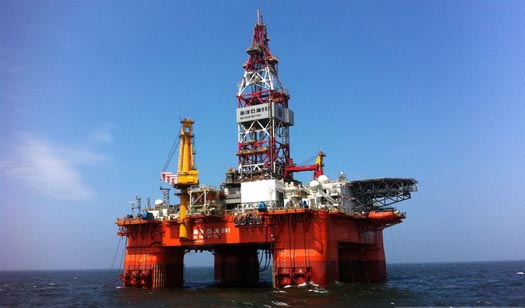
You can Email me to: [email protected]
Follow me on Twitter: @TomMacSweeney and on Facebook
GET THE MONTHLY NEWSLETTER: Sign-up at: [email protected] to receive my monthly newsletter summary to your Email on the first Friday of each month. Please put 'newsletter' in the subject line of your email.
Fisherman Convicted on Fisheries Charges
#FISHING – The Master of a UK fishing vessel pleaded guilty to fisheries offences at a recent case brought before Cork Circuit Court– Mr Eustaquio Docambo, the Master of the vessel, the Susa Uno, was fined and forfeited the value of the catch and gear to the value of €27,000.
The case arose following the detention of the fishing vessel in Castletownbere, Co Cork, on the 22nd April 2012 by Sea-Fisheries Protection Officers of the Sea-Fisheries Protection Authority (SFPA). The SFPA routinely inspect fishing vessels when they land to ensure they have an accurate record of all fish onboard. These records are used to monitor the total amount of fish caught to ensure that the limits recommended for the sustainable exploitation of fish stocks are respected. Whitefish stocks such as cod are currently being rebuilt from dangerously low levels by the application of special fisheries regulations regarding the catching of cod and the reduction of the amounts that are allowed to be caught at this time.
When the Susa Uno was inspected by Sea-Fisheries Protection Officers, a significant mismatch was discovered between the quantities of cod and additional fish recorded in the vessel's fishing logbook and the fish found in the fish-hold – the discrepancy included 3.4 tonnes of cod as well as 1,300kg of other fish species. Evidence was presented during the trial that the Master of the Susa Uno was previously detained and convicted for illegal fishing activity at Cork Circuit Court in June 2010.
Andrew Kinneen, Board Member of the SFPA welcomed the outcome of the case and said: "It is essential that all fishermen play their part in the rebuilding of damaged fish stocks such as cod if fishing is to be sustainable and profitable into the future. The requirement for fishermen to accurately record their catches and to keep within quota limits is a cornerstone of measures to rebuild damaged fish stocks and to share the burden of this stock recovery fairly among fishermen. The SFPA's inspection programme is intended to detect illegally caught fish and to protect the livelihoods of the many fishermen who respect the rules in place that safeguard the sustainable exploitation of valuable fish stocks. Stock recovery is good news for fishermen and ultimately leads to better fishing possibilities for the sector as well as improved market supply for consumers."


























